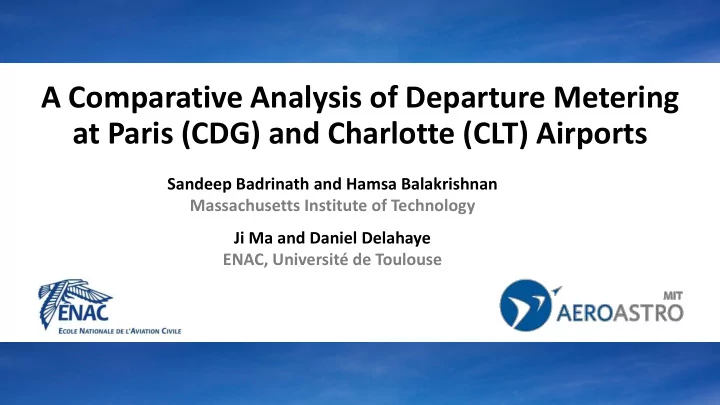

A Comparative Analysis of Departure Metering at Paris (CDG) and Charlotte (CLT) Airports Sandeep Badrinath and Hamsa Balakrishnan Massachusetts Institute of Technology Ji Ma and Daniel Delahaye ENAC, Université de Toulouse
Motivation Problem : Demand exceeds capacity at major airports surface congestion o Results in increased taxi times, emissions and fuel burn Potential solution : Departure metering Departure gates Departure gates Default procedures 6 5 4 3 6 Large queue 5 4 3 1 2 2
Motivation Problem : Demand exceeds capacity at major airports surface congestion o Results in increased taxi times, emissions and fuel burn Potential solution : Departure metering Departure gates Departure gates Hold aircraft at gate 6 5 4 3 6 5 4 Smaller queue 3 2 2 1 o Part of surface management programs: FAA TFDM (NASA ATD-2), EUROCONTROL’s A-CDM Key challenge: Develop an efficient algorithm that yields high taxi time reduction without adversely impacting airport throughput.
Our approach Assessment of different departure metering algorithms o Trajectory-based approach o Queue-based approaches: ATD-2 logic, Optimal control, Robust control. Comparison of benefits for a major US airport (CLT) and a major European airport (CDG) o Models developed and validated using operational data. o Benefits computed using stochastic simulations.
Key results and next steps Average taxi-out time reduction per flight varies by approach o CDG: 0.2 to 0.5 min o CLT: 1.3 to 2.9 min Robust control approach performs better in stochastic environments without adversely impacting airport throughput. Potential extensions: o Evaluating the impact of airline supplied Earliest Off-Block Time (EOBT) on departure metering. o Departure metering algorithms that can explicitly account for uncertainties in arrival times and EOBT. o Analysis can be easily extended to other major airports to evaluate NAS wide benefits.
Recommend
More recommend